Discover 7 hidden attractions, cool sights, and unusual things to do in Gorce National Park (Poland). Don't miss out on these must-see attractions: Suhora, Gorce Mountains, and Bulandowa Kapliczka. Also, be sure to include Papieżówka in your itinerary.
Below, you can find the list of the most amazing places you should visit in Gorce National Park (Lesser Poland).
Table of Contents
Suhora
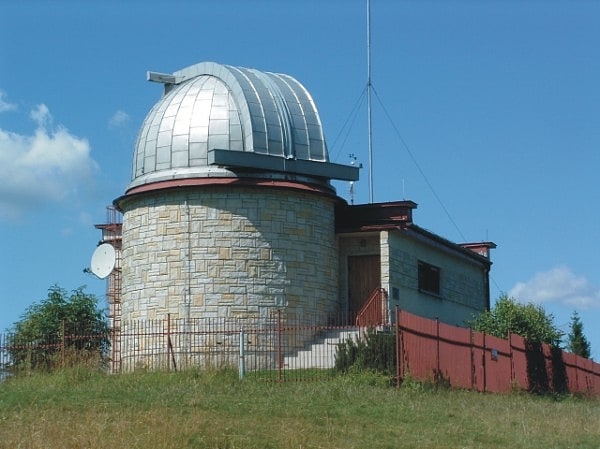
Also known as: Obserwatorium astronomiczne na Suhorze
Astronomical observatory. The Mount Suhora Observatory is an astronomical observatory owned and operated by the Astronomy department of the Pedagogical University of Cracow. It is located on Mount Suhora in the Gorce Mountains within the Gorce National Park, 50 km south of Kraków.[1]
Gorce Mountains
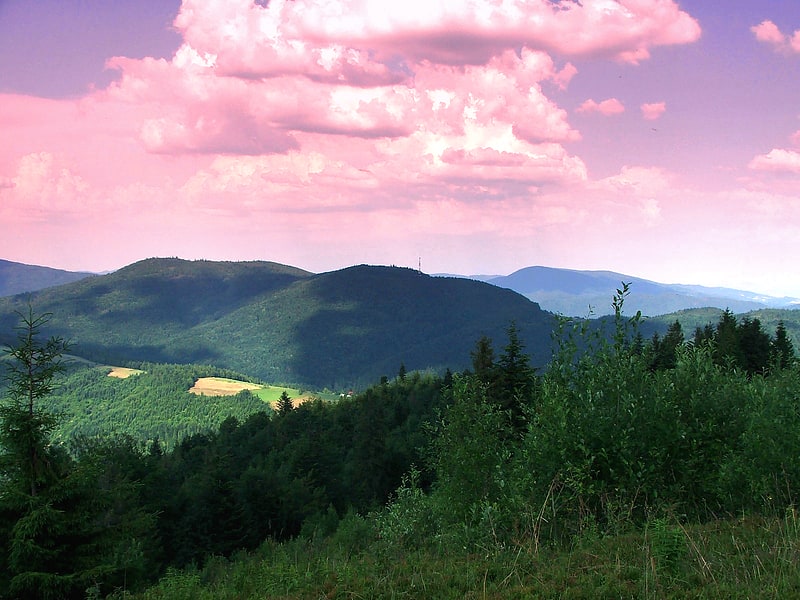
Also known as: Gorce
Mountain range in Poland. The Gorce Mountains are part of the Western Beskids mountain range spreading across southernmost Poland. They are situated in Małopolska Province, at the western tip of the long Carpathian range extending east beyond the Dunajec River for some 1,500 kilometres. The Gorce are characterized by numerous ridges reaching in all directions for up to 40 kilometres east–west with a series of higher elevations cut by deep river valleys.
The range is dominated by about a dozen gentle peaks including Turbacz (the highest, at 1,310 metres (4,300 ft) above sea level) in the centre, and – facing east: Jaworzyna Kamienicka (1,288 metres (4,226 ft)), Kiczora (1,282 metres (4,206 ft)), Kudłoń (1,276 metres (4,186 ft)), Przysłop, Czoło and Gorc Kamienicki. The south-eastern ridge of the Gorce reaches the Pieniny range (cut off by the Ochotnica pass), with Lubań (1,225 metres (4,019 ft)) as its tallest peak followed by Pasterski Wierch, Runek and Marszałek. The north-west ridges include Obidowiec, and the peak of Suhora (1,000 m (3,300 ft)) featuring an astronomical observatory owned and operated by the Pedagogical University of Kraków.
There are a number of smaller caves in the Gorce, carved out in sedimentary rock and its conglomerates which form the Carpathian Flysch Belt. High annual rainfall is caused by the air forced up by the mountains and accumulating into clouds. Rain water flows fast in all directions due to dense ground and ground-cover; feeding the Raba river on the north-west side of the Gorce, and the Dunajec on the south-east side. Other rivers, formed by the mountains include the Kamienica (35 kilometres (22 mi) in length), the Ochotnica (24 kilometres (15 mi)) and the Porębianka (13 kilometres (8.1 mi)), as well as large streams such as the Turbacz, the Gorcowy and the Łopuszna among others. The main city is Nowy Targ on the Dunajec below in the valley of Podhale, with large recreational villages including Krościenko nad Dunajcem, Szczawa and Ochotnica.[2]
Bulandowa Kapliczka
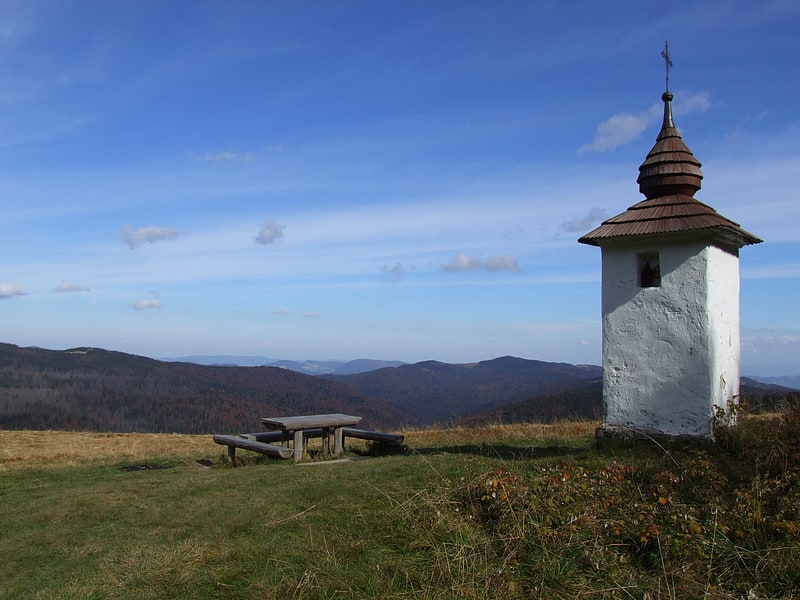
Bulanda's chapel - a chapel in the clearing of Jaworzyna Kamienicka on Jaworzyna Kamienicka - the second highest peak in the Gorce Mountains. It was founded in 1904 by Tomasz Chlipała, the most famous shepherd from Gorce, called Bulanda, who for more than 50 years was engaged in shepherding sheep and oxen on this clearing. In addition, he was a well-known medicine man, healed people and animals, and was also considered a sorcerer.
There are many folk tales about this shrine. According to one of them Bulanda saw in his sleep numerous souls atoning for their sins, wandering in the mountains and having nowhere to bend their knees to kneel before the consecrated place. He founded a chapel for them. It is guarded by venomous snakes. Indeed, Bulanda lived to a ripe old age and was rich by local standards, but his income came mainly from shepherding. According to another version, Bulanda's daughter, who died earlier, asked her father in a dream to build a chapel in the clearing, using local materials: stones and sand and spring water from the Kamienica stream near Borek Pass.
There is also a legend associated with the chapel which says that Bulanda erected the chapel on the spot where he found the treasure, and under the chapel he hid his magic book. Another version of the legend says that Bulanda hid these found treasures in this place. Its owners were said to have deposited the treasure precisely there, in the belief that the Lord God would guard the robber's goods, and people, fearing sacrilege, would never move it. However, Tomasz Chlipała revealed his secrets to one of the shepherds from near Babia Góra just before his death. Supposedly, when he tried to dig out the treasure from there, a lightning bolt or vipers (depending on the version of the legend) scared him off.
The shrine is located in the upper corner of one of the most beautiful clearings in Gorce. Beautifully presented from here is the nearby Kudłoń and Gorc, extensive views of the Beskid Sądecki and Wyspowy. Next to it there are benches for tourists. By the tourist trail on the edge of the clearing the information board with a panorama of the peaks that can be seen from here. Next to the chapel, on the western side the yellow trail (15 minutes) leading through the forest to Zbójecka Jama, which is associated with many legends.
The chapel is the oldest sacred monument in the Gorce National Park. In 1996, 92 years old chapel was renovated by the employees of GPN and the heir of Tomasz Chlipala. It is located within the village of Zasadne in Lesser Poland Voivodeship, in the Limanowa district, in the municipality of Kamienica.
Papieżówka

Papieżówka - a clearing in the valley of the Kamienica River in the Gorce Mountains, in a place where from the slopes of the Gorce Mountains its tributary, the Ustępny Stream, flows into the Kamienicki Stream. Papieżówka is located in the area of the Gorce National Park, within the village of Zasadne in Małopolska province, in the Limanowa district, in Gmina Kamienica.
It is a small clearing on the right bank of the Kamienica Creek. There is one hut there. In August 1976, for two weeks in the clearing lived Karol Wojtyla, the then Metropolitan of Krakow. He held days of recollection and wandered in the Gorce. He chose this place because of the remoteness, peace, and also because he already knew the Gorce from his previous wanderings. He lived in spartan conditions; the only equipment in his hut was a wooden table, a stool made of a tree trunk and a bunk made of branches. He piled the stones in front of the hut with his own hands. Nobody recognized him during his stay in Gorce.
The upper part of the clearing is currently used as a timber yard. To commemorate the stay of Cardinal Wojtyla, a large boulder with a commemorative plaque was placed in the clearing. It features an inscription quoting words that Karol Wojtyla, already as Pope John Paul II, said during one of his pilgrimages to Poland: "Guard these trails for me". The hut was restored in 2004.
Tobołczyk
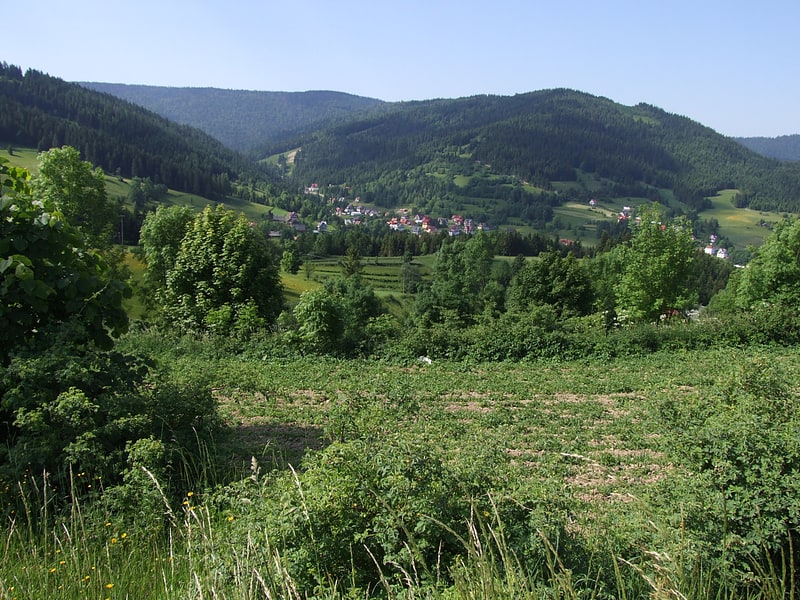
Tobołczyk - an unexplored peak in the Gorce Mountains. It is located in the side ridge departing from Obidowiec to the north. In this ridge there are successively: Suchora, Tobołów, Tobołczyk and Bórczane. The western slopes of the ridge descend to the Porębianka valley, the eastern to the Koninka valley. The Tobołczyk peak itself is covered by forest and is located within the Gorce National Park, but on its northern side there is a clearing called Jaworzyna Porębska. The clearing and the northern slopes are already outside the park.
Recently Tobołów and Tobołczyk have become one of the mountain biking centers in Poland. On their north-eastern slopes, descending to Koninki, several downhill courses have been created for mountain bikers, who practice, among others, freeriding here. The slopes are equipped with wooden jumping platforms, natural terrain "jumps" and other obstacles typical for this sport. The Tobolov chairlift also carries cyclists with bicycles up the mountain.
Tobołczyk is located in Koninki (part of the village of Poręba Wielka in the Małopolska province, in the Limanowa county, in the Niedźwiedź municipality).
Jaworzyna Kamienicka

Jaworzyna Kamienicka - a peak of the Gorce Mountains, second in height after Turbacz and the highest peak of the Gorce National Park. It is one of the many arms of Turbacz. By the highlanders it was also called Jaworzyna Bulandowa.
Just before World War I the forests on Jaworzyna Kamienicka and in the vicinity of Polana Gabrowska were completely cleared and the wood harvested from them was sent to Prussian and Hungarian factories. In 1914. Kazimierz Ignacy Sosnowski wrote: It is wild here, deaf and desolate, and the forests that decorated it lay under the axe. Currently, the slopes of Jaworzyna Kamienicka are overgrown by the spruce forest of the upper reglave. The peak itself is not prominent, poorly distinguished from the flat plateau. Because of the flat terrain, the mountain is wet in many places. However, the mountain is one of the most scenic in the Gorce, thanks to the fact that on its north-eastern slopes, slightly below the top, there is a clearing called Jaworzyna. It offers views of the nearby Kudłonia and Gorce summits with their peaks, the deep valley of the Kamienica creek and the peaks of the Beskid Wyspowy and Sadecki. By the tourist trail in the clearing there is an information board with a panorama of the peaks and the description of the clearing. In the upper corner of the clearing there is the so-called Bulanda's chapel, dating from 1904. It is the oldest monument of sacral art located within the boundaries of the Park. It was built by the legendary Gorce shepherd and sorcerer, Tomasz Chlipała, known as Bulanda. He grazed sheep and oxen in this clearing for over 50 years. Legend has it that he left the shepherd's hut at the age of 100, owing his excellent health to a recipe for a drink of happiness and longevity.
On the western edge of Jaworzyna there is a slot cave in Jaworzyna in the Gorce Mountains (also called Zbojecka Jama), which, according to legend, was the hideout of many local bandits. Supposedly, the area is haunted by the chopped-off head of the deputy head of the bandits. As he was much better than the leader, the latter deceitfully killed him and threw his head into a ravine. According to legend, when someone finds it, it will return to its place, because it is so attached to Jaworzyna.
Jaworzyna Kamienicka used to be a sanctuary for wolves. Sebastian Flizak in 1936 wrote a story about how a shepherd picked wolfdogs from a burrow and kept them in a hut, which was later besieged by a pack of wolves.
Through Jaworzyna Kamienicka runs the border between the villages Zasadne in Limanowski district (northern slopes) and Ochotnica Górna in Nowy Targ district (southern slopes).
Kudłoń
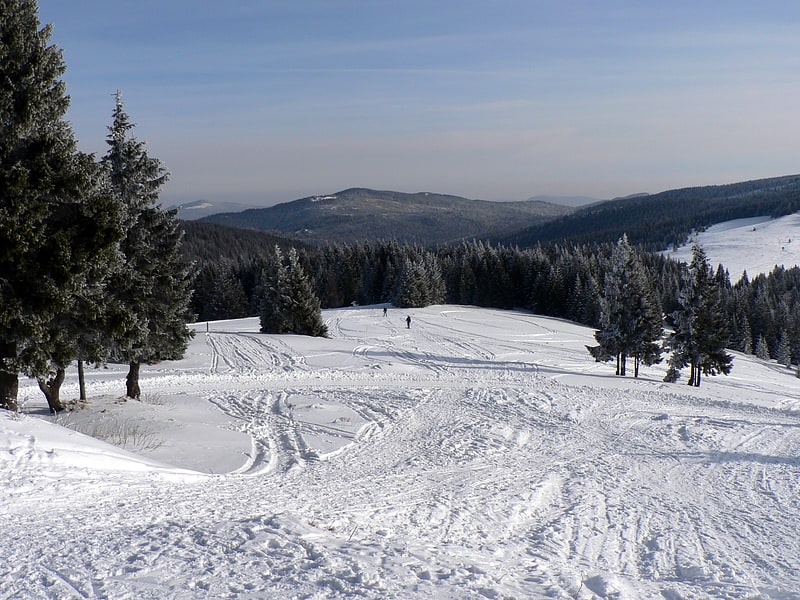
Kudłoń - the fourth highest peak in the Gorce, located northeast of Turbacz, in the ridge connecting Turbacz with the Beskid Wyspowy. It is the highest peak of the Gorce National Park. Its name derives from the surname Kudeł or Kudła.